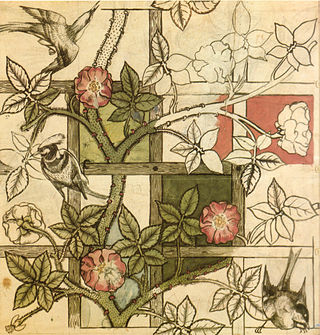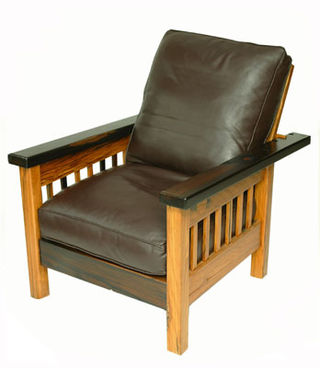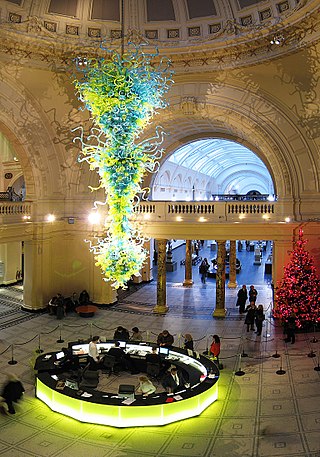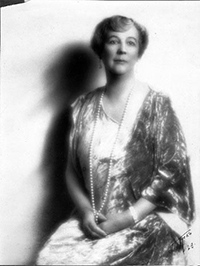
"Craftsman furniture" refers to the Arts and Crafts Movement style furniture of Gustav Stickley's Craftsman Workshops.

"Craftsman furniture" refers to the Arts and Crafts Movement style furniture of Gustav Stickley's Craftsman Workshops.
Stickley began making American Craftsman furniture in 1900, though he did not change the name of his firm to the Craftsman Workshops until 1903. It was sometimes popularly referred to as Mission Style Furniture, a term which Stickley despised. The company ceased making furniture in 1916.

The Arts and Crafts movement was an international trend in the decorative and fine arts that developed earliest and most fully in the British Isles and subsequently spread across the British Empire and to the rest of Europe and America.

Harmony Township is a township in Susquehanna County, Pennsylvania, United States. The population was 512 at the 2020 census.
Craftsman may refer to:

Gustav Stickley was an American furniture manufacturer, design leader, publisher, and a leading voice in the American Arts and Crafts movement. Stickley's design philosophy was a major influence on American Craftsman architecture.
Mission Style may refer to:

A Morris chair is an early type of reclining chair. The design was adapted by William Morris's firm, Morris & Company, from a prototype owned by Ephraim Colman in rural Sussex, England. It was first marketed around 1866.

American craft is craft work produced by independent studio artists working with traditional craft materials and processes. Examples include wood, glass, clay (ceramics), textiles, and metal (metalworking). Studio craft works tend to either serve or allude to a functional or utilitarian purpose, although they are just as often handled and exhibited in ways similar to visual art objects.

American Craftsman is an American domestic architectural style, inspired by the Arts and Crafts movement, which included interior design, landscape design, applied arts, and decorative arts, beginning in the last years of the 19th century. Its immediate ancestors in American architecture are the Shingle style, which began the move away from Victorian ornamentation toward simpler forms; and the Prairie style of Frank Lloyd Wright.

Craftsman Farms is a historic house located in Parsippany-Troy Hills, Morris County, New Jersey, United States. It was founded by noted early 20th century designer Gustav Stickley as a farm and school for the Arts and Crafts movement. It remained in use until 1915 when it was sold to a family and became a private house.

Harvey Ellis was an architect, perspective renderer, painter and furniture designer. He worked in Rochester, New York; Utica, New York; St. Paul, Minnesota; Minneapolis, Minnesota; St. Joseph, Missouri; St. Louis, Missouri and Syracuse, New York.

Mission furniture is a style of furniture that originated in the late 19th century. It traces its origins to a chair made by A.J. Forbes around 1894 for San Francisco's Swedenborgian Church. The term mission furniture was first popularized by Joseph P. McHugh of New York, a furniture manufacturer and retailer who copied these chairs and offered a line of stylistically related furnishings by 1898. The word mission references the Spanish missions throughout colonial California, though the design of most Mission Style furniture owed little to the original furnishings of these missions. The style became increasingly popular following the 1901 Pan-American Exposition in Buffalo. The style was popularly associated with the American Arts and Crafts movement.

The Gustav Stickley House is a three-story wood frame Queen Anne style house in Syracuse, New York.

The Craftsman was a magazine founded by the American furniture designer Gustav Stickley that championed the American Arts and Crafts movement.

Thomas Day (1801–1861) was an American furniture craftsman and cabinetmaker in Milton, Caswell County, North Carolina. Born into a free Black family in Dinwiddie County, Virginia, Day moved to Milton in 1817 and became a highly successful businessman, boasting the largest and most productive workshop in the state during the 1850s. Day catered to upper-class white clientele and was respected among his peers for his craftsmanship and work ethic. Day came from a relatively well-off family and was privately educated. Today, Day's pieces are highly sought after and sell for high prices; his work has been heavily studied and displayed in museums such as the North Carolina Museum of History. Day is celebrated as a highly skilled craftsman and savvy businessman, specifically in regards to the challenges his race posed to his success in the Antebellum South.
Charles P. Limbert (1854-1923) was an American furniture designer. He is considered one of the most successful furniture leaders in the history of Grand Rapids and the Arts and Crafts movement in America. The furniture that bears his name is highly sought after and seriously collected to this day. His designs were mainly inspired by such diverse influences as English Arts and Crafts, Dutch folk furniture, Scottish architect/designer Charles Rennie Mackintosh, and the Vienna Secession.

The Lewis T. Gilliland House is a historic residence in Portland, Oregon, United States. An excellent 1910 example of the American Craftsman style, it was designed by prominent Portland architect Ellis F. Lawrence by closely adapting plans published by Gustav Stickley. Stickley was the leading national exponent of Craftsman architecture, and no other work by Lawrence so precisely captures Stickley's aesthetic.

Ammonia fuming is a wood finishing process that darkens wood and brings out the grain pattern. It consists of exposing the wood to fumes from a strong aqueous solution of ammonium hydroxide which reacts with the tannins in the wood. The process works best on white oak because of the high tannin content of this wood. Fumed oak is also called smoked oak. Other species may also be fumed, but usually will not darken as much as white oak. The introduction of the process is usually associated with the American furniture maker Gustav Stickley at the beginning of the 20th century, but fuming was certainly known in Europe before this.

Elizabeth Eaton Burton (1869–1937) was an American artist and designer whose work typified the Arts and Crafts style in southern California.

Carlos and Anne Recker House, also known as the Recker-Aley-Ajamie House, is a historic home located at Indianapolis, Marion County, Indiana. It was built in 1908, and is a 1+1⁄2-story, Bungalow / American Craftsman style frame dwelling. It has a steeply pitched side-gable roof with dormers. The house was built to plans prepared by Gustav Stickley through his Craftsman Home Builder's Club.
Ernest George Washington Dietrich, AIA was an American architect. Born and raised in Pittsburgh, Pennsylvania, Dietrich relocated to New York City in 1886 where he would practice for nearly forty years. His work included the design of churches, libraries, hotels, commercial and public buildings, but he is most highly regarded for his residential designs in the shingle, colonial revival, and arts and crafts styles. In cooperation with furniture designer Gustav Stickley, Dietrich designed the first “Craftsman House” published in The Craftsman magazine in May 1903.